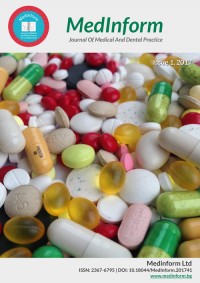Issue One 2017
2017, Vol. 4, issue 1, (March)
Original Article
The role of sensitization to dental materials for the manifestation of idiopathic urticaria and angioedema
Abstract:
Idiopathic urticaria and angioedema are states of unclear etiology, abruptness and unpredictability. Approximately 40-50% of patients with chronic spontaneous urticaria have angioedema, as well and about 10% of them have isolated angioedema [1,2]. Modern dental treatment is associated with the usage of different dental materials. Their influence is mixed and often associated with negative consequences such as the occurrence of mucosal lesions, burning mouth syndrome and even urticaria and angioedema. The allergic reaction to dental materials occurs most frequently as IV-th type of reaction from Coombs & Gell’s classification [3,4]. The immunological basis of patchtest is type IV (cell-mediated or delayed) hypersensitivity reaction. In this case, specifically sensitized T-lymphocytes have a secondary contact with the antigen that is usually in hapten form conjugated to a protein and expressed on the surface of antigen-presenting cell (APC). Langerhans cells (LC) are the main APC in the skin located basically in the epidermis, where they form a net. They are dendritic cells of bone marrow origin having on their cell surface a number of receptors of Class II of the main histocompatibility complex (MHC) and T-cell receptors. Capturing the antigen and presenting it on the surface, LC leave the epidermis and migrate into regional lymph nodes.
Once the antigen has been introduced by LC mainly into CD4 + Th-1 lymphocytes, a cascade of cytokine release follows, produced basically by T-cell activation as well as other non-antigen specific T-cells and macrophages in this zone. Then, as a result, inflammation follows. The key cytokines are IL-1, IL-2, IL-3 and gamma-interferon. Inflammatory response reaches its peak at 72-nd hour and clinically manifests itself in the area of patch as localized eczema [5,6].
Apart from the latex, which is a complete allergen, most dental materials are haptens, i.e. incomplete allergens. Their molecule must be linked to another one – more complex, such as a protein to cause allergic reactions. Haptens bind to protein or carbohydrate molecules of saliva, gingival fluid or blood and turn into unexpected allergenic permanent depots in the oral cavity [7,8]. Therefore we focused on studying the potential of dental materials to give rise to and maintain the allergic diseases urticaria and angioedema.
Authors:
Maria Dencheva; Medical University-Sofia, FDM, Department of oral and image diagnostics;Maya Ljapina; Medical University-Sofia, Medical Faculty, Department of Hygiene, medical ecology and nutrition;
Dimitar Iovchev; Medical University-Sofia, FDM, Department of oral and image diagnostics;
Elena Petkova; Medical University-Sofia, UMBAL Alexandrovska, Clinical center of allergology;
Denislava Nedeva; Medical University-Sofia, UMBAL Alexandrovska, Clinical center of allergology;
Anna Valerieva; Medical University-Sofia, UMBAL Alexandrovska, Clinical center of allergology;
Stella Hristova; Private dental practice – Sofia;
Vassil Dimitrov; Medical University-Sofia, UMBAL Alexandrovska, Clinical center of allergology;

